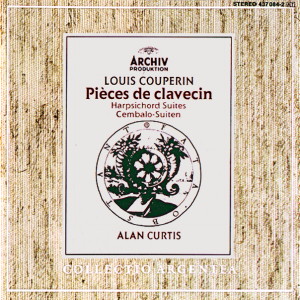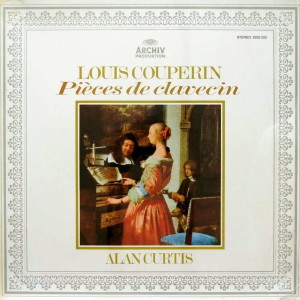 |
|
1 CD -
437 084-2 - (c) 1986
|
 |
| 1 LP -
2533 325 - (p) 1976 |
|
| LOUIS COUPERIN -
Pièces de clavecin |
|
|
|
|
|
| Louis
Couperin (ca.1626-1661) |
|
|
| Suite en sol
mineur |
|
|
| - Prélude |
3'
39" |
|
| - Allemande |
2'
53" |
|
| - Courante |
1'
47" |
|
| - Passacaille |
5'
20" |
|
| - Chaconne |
1'
44" |
|
| Suite en ré
majeur |
|
|
| - Prélude |
3'
03" |
|
| - Allemande |
4'
23" |
|
| - Courante |
1'
22" |
|
| - Sarabande |
1'
44" |
|
| - Chaconne |
2'
31" |
|
| Suite en la
mineur |
|
|
| - Prélude à
l'imitation de Mr. Froberger |
6'
02" |
|
- Allemande
l'Amiable
|
2'
24" |
|
| - Courante dite La
Mignonne |
1'
17" |
|
- Seconde Courante
|
1'
50" |
|
| - Sarabande |
2'
36" |
|
| - La Piémontaise |
1'
47" |
|
| Suite en fa
majeur |
|
|
| - Prélude |
2'
25" |
|
- Allemande grave
|
3'
21" |
|
| - Courante |
1'
17" |
|
- Branle de Basque
|
0'
58" |
|
| - Chaconne |
3'
07" |
|
|
|
|
Alan
Curtis, Cembalo
(signed "D.F."; 17th century, private
collection)
|
|
|
|
|
|
Luogo
e data di registrazione |
|
Salons
Hoche, Paris (Francia) - ottobre
1975 |
|
|
Registrazione:
live / studio |
|
studio |
|
|
Producer /
Engineer |
|
Andreas
Holschneider / Heinz Wildhagen |
|
|
Prima Edizione
LP |
|
Archiv
- 2533 325 - (1 lp) - durata 55'
44" - (p) 1976 - Analogico |
|
|
Edizione
"Collectio" CD |
|
Archiv
- 437 084-2 - (1 cd) - durata 55'
44" - (c) 1986 - ADD |
|
|
Note |
|
-
|
|
|
|
|
LOUIS
COUPERIN:
SUITES FOR
HARPSICHORD
For
the general public,
“Couperin” still means only
“François-le-Grand”.
But the situation is
changing, and more and more
connoisseurs are coming to
realize that theCouperin who
served the Sun King at the
dawn of his reign was very
nearly as great and
certainly as original as the
more famous one who served
at the sunset of the Grand
Siécle.
The lifetime of Louis was
tragically short - he died
in 1661, in his mid-thirties
- and none of his music was
ever published until modern
times. All his mature
compositions were written in
the span of a single
troubled decade from the
revolt of the Fronde to the
marriage of the monarch.
During that time he was
active as a treble viol
player in Lully ballets, as
organist of St. Gervais, and
as harpsichordist not only
to the King but also to the
celebrated diplomat Abel
Servien, at whose magnificent
palace at Meudon Couperin
must often have been
resident. The castle was
destroyed in 1804, and all
that remains today are the
splendid terraces - and some
pink marble columns now
admired by every passing
Paris tourist as part of
Napoleon’s Arc du Carrousel!
Probably the greater part of
Louis Couperin’s music has
also been destroyed over the
ages. He never married, and
when he died, he left, along
with little else than a
small spinet, a large
collection of autograph
music, divided between his
two brothers, who found the
inheritance “presque plus
onéreuse que proffitable”.
Only two important sources
for his harpsichord music
have survived: the Bauyn
manuscript in Paris and the
Parville manuscript in
Berkeley, California.
Neither is autograph, and
although they were based on
a common source (not
autograph either), there are
many variants - especially
in ornamentation, which is
more abundant in Parville.
Neither source conveys more
than a vague impression of
the composer’s intentions
for forming his pieces into
suites. I have thus chosen
my own arrangement, based on
the common practice of the
time.
I have included a large
proportion of chaconnes en
rondeau, for
it was in this form that
Couperin wrote much of his
best dance music. Some
listeners will know the F
major chaconne as a work of
Chambonnières.
It is indeed attributed to
him in the Bauyn manuscript.
However, in all other
sources it is anonymous, and
it was not included in
either of Chambonnières’s
published books. I feel
strongly, on the basis of
both quality and style, that
it is more likely by
Couperin.
La Piémontaise is not
a dance known to me; Laborde
mentions a 17th-century
singer given this name, but
she would seem to have been
too young to be the one
Couperin had in mind. In any
case, it is not a very
feminine piece!
I begin each suite with a
beautiful example of those
unmeasured preludes which
are justly his most
celebrated works. The
longest, in A minor, “a
l’imitation de Mr.
Froberger”, reveals at once
two of the principle sources
of this style: the Italian toccata
and the French tombeau
(or plainte,
or allemande
grave). The opening is
a carefully notated version
of how one might improvise
the arpeggiation of the
opening chord of an Italian
toccata, as described
already by Frescobaldi. It
is, in fact, a quotation of
the opening of Froberger’s
Italianate toccata in the
same key. Almost immediately
thereafter follows an even
more exact quote from
Froberger’s “Plainte faite à
Londres pour passer la
Mélancholie, laquelle se
joue lentement avec
discrétion”, written
probably in 1652 after
Froberger had been robbed
“theils zu Wasser, theils zu
Land”, and shortly before
his visit to Paris, where he
befriended Couperin. The
rest of the piece may or may
not conceal references to
other pieces of Froberger
now lost; it reveals, in any
case, the strong stylistic
affinity
of the two masters, who must
have learned much from each
other.
Although Couperin’s
unmeasured preludes are at
once the first
and the finest ever written
for the harpsichord, they
were preceded, and probably
much influenced by, the
improvisatory tuning
preludes of the French
lutenists. With the advent
of the nouveau ton
(D minor instead of quartal
tuning) around 1630-50,
players of Baroque lute and
theorbo began to write down
brief improvisatory
preludes, often beginning
and ending with only open
strings. They used slurs to
give a vague indication of
duration and harmonic
movement, and would omit the
usual symbols for rhythm
altogether. Couperin adapted
this notation to the
keyboard by using rhythmless
semibreves (whole notes) as
the unit and employing slurs
not only for harmonic
duration but also for
melodic groupings. The
result is a puzzling picture
which must have caused some
confusion even to
17th-century players.
Lebegue (1677) spoke in his
preface of the “grande
difficulté” of notating
these rhythmically free
pieces, and d’Anglebert
altered the notation of
three of his when he
published them (1689),
changing semibreves to
quavers (eighth notes) or
semiquavers (sixteenth
notes) when he wanted to
indicate brief melodic as
opposed to harmonic ideas.
Finally, François
Couperin abandoned his
uncle’s notation entirely,
explaining that “j’ai mesure
ces Préludes”, to make them
easier to teach and to
learn, but that “il y a
cependant un goût
d’usage qu’il faut suivre”.
Preludes, even if notated as
measured, must still be
played freely and music must have
its prose as well as its
verse. Yet even the
“prose” of François
no longer aspires to the
freedom, abandon and
intensity of his uncle’s
preludes.
Until quite recently,
harpsichordists were
stymied by the style and
especially the notation of
Louis Couperin’s preludes,
and it was perhaps largely
for this reason that the
music of this great
composer was neglected by
them. In 1956, I wrote a
thesis on unmeasured
preludes, and at that time
I was the only
harpsichordist performing
such music. It gives me
great pleasure to share in
what is now a general and
widespread revival of
interest in the works of a
composer who, together
with his friend Froberger,
must be regarded as the
finest and most original
keyboard composer of his
day.
Alan
Curtis
The Harpsichord
The instrument used for
this recording is a
two-manual harpsichord of
the second half of the
17th century, graciously
lent by its owner,
Monsieur Yannick Guillou,
Paris. It has the usual
push-pull coupler, with
two unisons and an octave.
The compass, which is
original, is four octaves
and a fourth, with GG
short octave and one split
key (apparent compass B-c"',
with low B
sounding G, C
sharp A, and the
front half of the split E
flat tuned either B
or B flat). In the
gilt rose, the initials
“D. F.”, of a maker not
yet identified, appear on
each side of a winged
angel playing a lyre. In
the second edition (1974)
of Donald Boalch’s Makers
of the Harpsichord and
Clavichord, this
instrument is listed not
only under “F., D.” but
also, with a slightly
varying description, under
“E., D.”, with the remark
that the E could be read
as a F. The maker was
probably French, to judge
from the bracing, the
scaling (shorter than the
Flemish), the walnut
wrest-plank, and the
staggered wrest-pins. The
exterior decoration, of
excellent quality, would
also appear to be French:
colorful grotesqueries on
a black ground; with
Orpheus playing a pardessus
de viole
and, inside a circular
garland, a group of
instrumentalists, singers
and conductor, dressed in
costumes of the later
Louis XIV period, gathered
around a table under a
chandelier. There are also
some Flemish elements,
however, in the general
dimensions, the bentside
curve, and the interior
decoration - especially
the gilt rose, the painted
soundboard, and the
landscape on the lid,
almost certainly by a
Flemish painter. The
instrument has recently
been restored as nearly as
possible to its original
condition by Johannes
Carda
of Varennes Jarcy.
For this recording we have
used the normal meantone
tuning of the era (all
major thirds are pure), as
recommended and described
by, among others, Jean
Denis, Traité de
l'accord de
l'espinette
(1643 and 1650, facsimile
reprint edited by A. Curtis,
Da Capo Press, New York,
1969). A small amount of
re-tuning is necessary for
certain suites - for
instance, our D major
pieces require A sharp
instead of B flats - but
Louis Couperin basically
never calls for
enharmonics. In our long G
minor Passacaille he does
use both E flats and D
sharps, but the latter
occur only three times,
and always as a dissonance.
Alan
Curtis
|
|